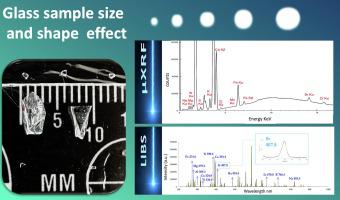当前位置:
X-MOL 学术
›
Forensic Chem.
›
论文详情
Our official English website, www.x-mol.net, welcomes your feedback! (Note: you will need to create a separate account there.)
Assessment of performance rates on the elemental comparison of small and irregular glass fragments using µ-XRF and LIBS
Forensic Chemistry ( IF 2.7 ) Pub Date : 2024-03-04 , DOI: 10.1016/j.forc.2024.100567 Oriana Ovide , Ruthmara Corzo , Tatiana Trejos
Forensic Chemistry ( IF 2.7 ) Pub Date : 2024-03-04 , DOI: 10.1016/j.forc.2024.100567 Oriana Ovide , Ruthmara Corzo , Tatiana Trejos

|
This study describes a systematic assessment of the performance rates when analyzing small and irregular glass fragments using micro-X-ray Fluorescence Spectrometry (µ-XRF) and Laser Induced Breakdown Spectroscopy (LIBS). One hundred glass fragments were collected from the inner and outer panes of a vehicle windshield to assess the false exclusion rates. Additionally, 100 glass fragments originating from different vehicle windshields were used to evaluate the discrimination capabilities. To compare the effects of fragment size on the performance rates, half of the collected fragments were small (longest length between 0.4 mm and < 1 mm, and thickness greater than 0.4 mm for LIBS and 0.1 mm for μ-XRF), and the other half were full-thickness fragments (2 mm and greater). The study shows that precision deteriorates for small/irregular fragments and comparison items must have a similar size, shape, and thickness to minimize error rates. Thus, comparisons between full-thickness and small/irregular fragments should be avoided, regardless of the analytical method. Although this general concept is well known for µ-XRF, this effect was not previously reported as a concern for LIBS. Moreover, this study provides new sampling and comparison recommendations when using modern silicon drift detectors (SDD) and reduced fragment size. Using a 3 s (3 %RSD) comparison interval reduces the false exclusion rates to < 12 % for µ-XRF, and to < 4 % for LIBS when using either a 3 s or 4 s (3 % RSD) criterion. At least 4 known fragments are recommended for full thickness fragments and 6 to 9 known fragments for the small/irregular comparisons.
中文翻译:

使用 µ-XRF 和 LIBS 评估小型和不规则玻璃碎片的元素比较性能
本研究描述了使用微 X 射线荧光光谱 (μ-XRF) 和激光诱导击穿光谱 (LIBS) 分析小且不规则玻璃碎片时的性能速率的系统评估。从车辆挡风玻璃的内外玻璃中收集了一百块玻璃碎片,以评估错误排除率。此外,还使用来自不同车辆挡风玻璃的 100 块玻璃碎片来评估辨别能力。为了比较碎片尺寸对性能率的影响,收集到的碎片中有一半是小碎片(最长长度在 0.4 毫米到 < 1 毫米之间,LIBS 的厚度大于 0.4 毫米,μ-XRF 的厚度大于 0.1 毫米),另一一半是全层碎片(2 毫米及以上)。研究表明,小/不规则碎片的精度会下降,比较项目必须具有相似的尺寸、形状和厚度,以最大限度地减少错误率。因此,无论采用何种分析方法,都应避免全层碎片和小/不规则碎片之间的比较。尽管这一一般概念对于 µ-XRF 来说是众所周知的,但这种效应之前并未被报道为 LIBS 所关注的问题。此外,这项研究在使用现代硅漂移探测器(SDD)和减小碎片尺寸时提供了新的采样和比较建议。使用 3 s (3 %RSD) 比较间隔可将 µ-XRF 的误排除率降低至 < 12 %,而当使用 3 s 或 4 s (3 % RSD) 标准时,LIBS 的误排除率可降低至 < 4 %。建议至少 4 个已知片段用于全厚度片段,6 至 9 个已知片段用于小/不规则比较。
更新日期:2024-03-04
中文翻译:

使用 µ-XRF 和 LIBS 评估小型和不规则玻璃碎片的元素比较性能
本研究描述了使用微 X 射线荧光光谱 (μ-XRF) 和激光诱导击穿光谱 (LIBS) 分析小且不规则玻璃碎片时的性能速率的系统评估。从车辆挡风玻璃的内外玻璃中收集了一百块玻璃碎片,以评估错误排除率。此外,还使用来自不同车辆挡风玻璃的 100 块玻璃碎片来评估辨别能力。为了比较碎片尺寸对性能率的影响,收集到的碎片中有一半是小碎片(最长长度在 0.4 毫米到 < 1 毫米之间,LIBS 的厚度大于 0.4 毫米,μ-XRF 的厚度大于 0.1 毫米),另一一半是全层碎片(2 毫米及以上)。研究表明,小/不规则碎片的精度会下降,比较项目必须具有相似的尺寸、形状和厚度,以最大限度地减少错误率。因此,无论采用何种分析方法,都应避免全层碎片和小/不规则碎片之间的比较。尽管这一一般概念对于 µ-XRF 来说是众所周知的,但这种效应之前并未被报道为 LIBS 所关注的问题。此外,这项研究在使用现代硅漂移探测器(SDD)和减小碎片尺寸时提供了新的采样和比较建议。使用 3 s (3 %RSD) 比较间隔可将 µ-XRF 的误排除率降低至 < 12 %,而当使用 3 s 或 4 s (3 % RSD) 标准时,LIBS 的误排除率可降低至 < 4 %。建议至少 4 个已知片段用于全厚度片段,6 至 9 个已知片段用于小/不规则比较。



























 京公网安备 11010802027423号
京公网安备 11010802027423号